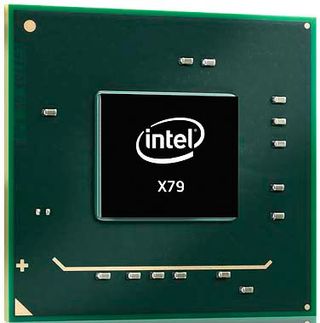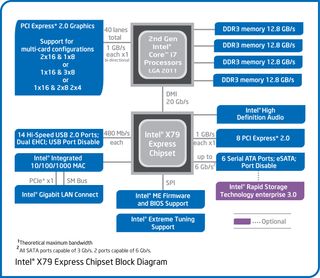Intel Core i7-3960X Review: Sandy Bridge-E And X79 Express
Intel's Sandy Bridge design impressed us nearly a year ago, but it was intended for mainstream customers. The company took its time readying the enthusiast version, Sandy Bridge-E. Now, the LGA 2011-based platform and its accompanying CPUs are ready.
X79 Express: P67, Is That You?
The Patsburg chipset (code name for the silicon on which X79 Express centers), as Intel originally planned it, was to have as many as 14 ports of storage connectivity. Six of them were SATA-based (2 x 6 Gb/s and 4 x 3 Gb/s), while as many as eight emanated from a separate, integrated storage controller. In its most decked-out form, that controller would have offered eight SAS 6 Gb/s ports. It also would have borrowed four of the processor’s 40 third-gen PCI Express lanes to create a x4 link dedicated to storage traffic.

Apparently, we’ll still see that souped-up rendition of Patsburg in 2012. But the company either couldn’t or didn’t enable it in X79 Express, leaving the chipset with the same two 6 Gb/s and four 3 Gb/s SATA ports we’ve seen for almost a year on the P67 Express chipset.
When you start looking around at the rest of X79’s features, you realize that, while the platform bears a new name, it’s pretty much P67 Express. You get the same 14 USB 2.0 ports, the same integrated gigabit Ethernet MAC, eight lanes of second-gen PCI Express, and HD Audio.

Now, Intel does include a driver called Rapid Storage Technology Enterprise 3.0, which is designed to facilitate the additional data protection servers and workstations will need once the more advanced versions of Patsburg emerge. For all of our testing, though, Microsoft’s native AHCI drivers are fine.
As a result, all of the changes inherent to the Sandy Bridge-E/X79 platform, at least on the desktop, are attributable to the processor. We’ll have to wait until next year for a more advanced platform—which motherboard vendors don’t seem to be sure what to do with yet, by the way.
I’m frankly not too concerned, though. Do I really need SAS support? No. Do I even need more than six SATA ports? Not really. More than anything, it’s a shame that Intel wasn’t able to incorporate native USB 3.0 support.
Stay on the Cutting Edge
Join the experts who read Tom's Hardware for the inside track on enthusiast PC tech news — and have for over 25 years. We'll send breaking news and in-depth reviews of CPUs, GPUs, AI, maker hardware and more straight to your inbox.
Current page: X79 Express: P67, Is That You?
Prev Page Quad-Channel Memory And PCI Express 3.0 Next Page Cooling And Overclocking Core i7-3960X-
SpadeM So no SAS/Full Sata 3 ports but u do get PCIe 3 ... no Quicksync but u do get 2 more cores and the added cache ... no USB 3.0 but u get quad channel memory which in real life every day computing is a minimal gain at best. Feels an awful lot like a weak trade if you ask me. I'm basically asked to buy the P67 chipset with sprinkles on top. And for 1000$ it feels like it falls short. For heavy workloads it's cheaper and faster to make yourself 2 systems based on 1155 or bulldozer and render, fold, chew numbers that way. X79 should have launched with an ivy bridge based cpu inside and a better chipset to live to it's name.Reply
What we have today is simply a platform for bragging rights not a serious contender to the X38, X48, X58 family. -
illfindu Not to take the review to much off topic but its worth bringing up because this review was so complete , as in covering a vast array of situations and programs. Its truly embarrassing for AMD that the FX-8XXX series is beaten not only bye chips with half the cores but half the cores that are a generation behind. In fact as of this moment the FX set is almost inspiring it its lack of any value at first glance at some of these marks one could say that AMD's most expensive chip at over 200$ is one of its slowest being beaten bye both the x4 and x6 phenoms.Reply -
redsunrises Illfindu, you are beating a dead horse... Old news, lets move on (sorry, just tired of the same thing being said over and over, which will end in an amd fanboy fight). Great review though!Reply -
ohim This article tells me 2 things , either our current software is a total piece of crap since it has absolutely no clue of multi core cpus, or the future without AMD is so grim that intel makes you pay 1000 bucks for a cpu that doesn`t perform really that fast ... but for sure the software industry needs to take a better look at those multicore optimisations.Reply -
stonedatheist I think Intel would be raking in the dough if they left all 8 cores enabled for the 3960X. I doubt that a later revision will enable them. 8c/16t will probably hit the desktop with IB-E (can't wait) :)Reply -
joytech22 :| Well AMD is fighting a losing battle.. (In High-End CPU's, which I actually use for rendering etc..)Reply
I would LOVE to see them pick up their game and provide me with a worthy upgrade over my 4GHz i7 2600 (Non-K). I would swoop it up.
Look, BD had 4 modules with two "cores" each, each module is equivalent to a Sandy Bridge core.
They should just combine both of those cores or make them a single core, so we get 4 threads.
Then create 4-6-8 core versions of those CPU's..
Think about it.. the FX8150 is more of a 4-core CPU where the resources are halved pretty much so you get two threads per core, it would have been MUCH MUCH better if they just kept 4 strong cores.
Not sure why either but I always seem to start an AMD related comment :\ -
JeanLuc Hi Chris,Reply
The labels are wrong on the graphs on this page the last ones should read DDR2-2133 on the last two shouldn't it?
JeanLuc
Most Popular


